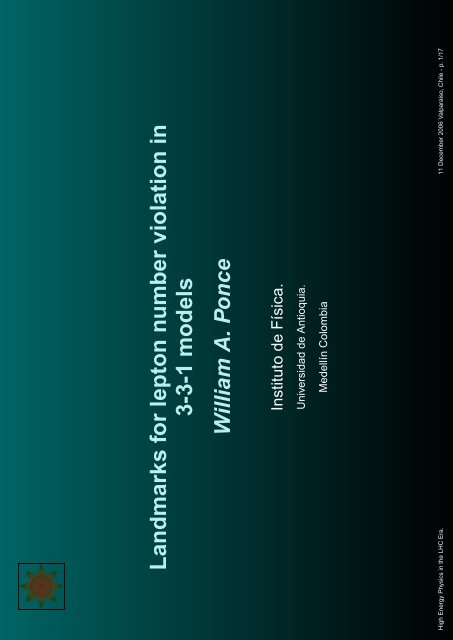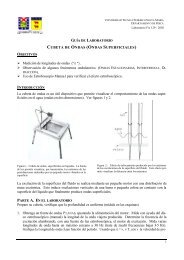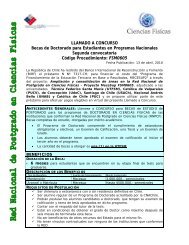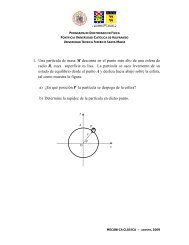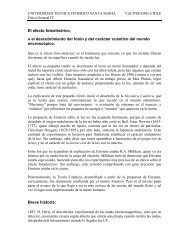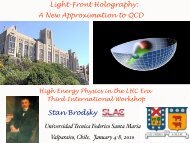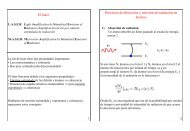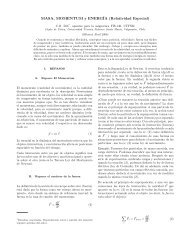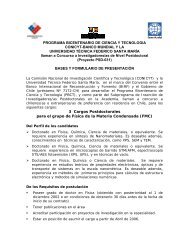Leptons - Departamento de Física
Leptons - Departamento de Física
Leptons - Departamento de Física
Create successful ePaper yourself
Turn your PDF publications into a flip-book with our unique Google optimized e-Paper software.
Landmarks for lepton number violation in3-3-1 mo<strong>de</strong>lsWilliam A. PonceInstituto <strong>de</strong> <strong>Física</strong>.Universidad <strong>de</strong> Antioquia.Me<strong>de</strong>llín ColombiaHigh Energy Physics in the LHC Era. 11 December 2006 Valparaiso, Chile - p. 1/17
3-3-1➲ 3-3-1➲ Electric Charge Operator➲ Pisano-Pleitez-FramptonMo<strong>de</strong>l b=3/2➲ The scalar sector➲ Lepton Number violation 1➲ Lepton Number violation 2➲ Mo<strong>de</strong>l with Right-Han<strong>de</strong>dneutrinos b=1/2➲ The scalar sector➲ Lepton Number Violation 1➲ Lepton Number violation 2➲ The economical 3-3-1mo<strong>de</strong>l b=1/2➲ Lepton Number Violation 1➲ Lepton Number Violation 2➲ The Majoron Gauged away➲ Mo<strong>de</strong>l with exotic electronsb=1/2➲ CONCLUSIONSSU(3)c ⊗ SU(3)L ⊗ U(1)X▲ Free of gauge anomalies iff NF multiple of 3 (only 3 ifassimptotic freedom of QCD is imposed).▲ Peccei-Quinn symmetry can be easily implemented.▲ Third quark family different from other two.▲ Scalar sector with good candidates for dark matter.▲ Suitable for explaining some neutrino properties.▲ Strong hierarchy in the Yukawas can be avoi<strong>de</strong>d (byimplementing universal see-saw mechanisms).C-Garcia Canal. H.Fanchiotti, L. EpeleHigh Energy Physics in the LHC Era. 11 December 2006 Valparaiso, Chile - p. 2/17
Electric Charge OperatorQ = λ 3L2+ bλ √ 8L3+ XI3➲ 3-3-1➲ Electric Charge Operator➲ Pisano-Pleitez-FramptonMo<strong>de</strong>l b=3/2➲ The scalar sector➲ Lepton Number violation 1➲ Lepton Number violation 2➲ Mo<strong>de</strong>l with Right-Han<strong>de</strong>dneutrinos b=1/2➲ The scalar sector➲ Lepton Number Violation 1➲ Lepton Number violation 2➲ The economical 3-3-1mo<strong>de</strong>l b=1/2➲ Lepton Number Violation 1➲ Lepton Number Violation 2➲ The Majoron Gauged away➲ Mo<strong>de</strong>l with exotic electronsb=1/2➲ CONCLUSIONSb = 1/2, 3/2, 5/2, . . . n/2▲ b = 1/2 mo<strong>de</strong>ls without exotic electric charges.▲ b = 3/2 the Pisano-Pleitez-Frampton mo<strong>de</strong>l (Minimal).For b = 1/2 there are:▲ 2 one family mo<strong>de</strong>ls reported in the literaure.▲ 4 different mo<strong>de</strong>ls reported in the literature.▲ 4 more three family mo<strong>de</strong>ls.If exotic electric charges are allowed, ∞ number of mo<strong>de</strong>ls.For SU(3)L∑αλαA α µ = √ 2⎛0 + (b+1/2)D 1µ 0 W µ + K µ(b+1/2)W µ − D 2µ 0 K µ(b−1/2)K µ −(b+1/2) K µ −(b−1/2) D 3µ0⎞⎟ ⎠ ,High Energy Physics in the LHC Era. 11 December 2006 Valparaiso, Chile - p. 3/17
Pisano-Pleitez-Frampton Mo<strong>de</strong>l b=3/2➲ 3-3-1➲ Electric Charge Operator➲ Pisano-Pleitez-FramptonMo<strong>de</strong>l b=3/2➲ The scalar sector➲ Lepton Number violation 1➲ Lepton Number violation 2➲ Mo<strong>de</strong>l with Right-Han<strong>de</strong>dneutrinos b=1/2➲ The scalar sector➲ Lepton Number Violation 1➲ Lepton Number violation 2➲ The economical 3-3-1mo<strong>de</strong>l b=1/2➲ Lepton Number Violation 1➲ Lepton Number Violation 2➲ The Majoron Gauged away➲ Mo<strong>de</strong>l with exotic electronsb=1/2➲ CONCLUSIONSQuarks:Q i L = (di , u i , X i )L ∼ (3, 3 ∗ , −1/3), i = 1, 2. Two families.Q 3 L = (u3 , d 3 , Y )L ∼ (3, 3, 2/3). Third family.X i , i = 1, 2 two exotic quarks Q = −4/3.Y an exotic quark. Q = 5/3.Right-Han<strong>de</strong>d quarksu acX icL ∼ (3∗ , 1, −2/3), d acL ∼ (3∗ , 1, 1/3) a = 1, 2, 3,,L ∼ (3∗ , 1, 4/3), i = 1, 2, Y L c ∼ (3∗ , 1, −5/3).<strong>Leptons</strong>LlL = (νl 0 , l− , l + )L ∼ (1, 3, 0), l = e, µ, τ. ν L 0cnot present.F.Pisano,V.Pleitez,Phys.Rev.D50,548(1994);P.Frampton,Phys.Rev.Lett 69,2889(1992)High Energy Physics in the LHC Era. 11 December 2006 Valparaiso, Chile - p. 4/17
The scalar sector➲ 3-3-1➲ Electric Charge Operator➲ Pisano-Pleitez-FramptonMo<strong>de</strong>l b=3/2➲ The scalar sector➲ Lepton Number violation 1➲ Lepton Number violation 2➲ Mo<strong>de</strong>l with Right-Han<strong>de</strong>dneutrinos b=1/2➲ The scalar sector➲ Lepton Number Violation 1➲ Lepton Number violation 2➲ The economical 3-3-1mo<strong>de</strong>l b=1/2➲ Lepton Number Violation 1➲ Lepton Number Violation 2➲ The Majoron Gauged away➲ Mo<strong>de</strong>l with exotic electronsb=1/2➲ CONCLUSIONS(1)〈η1〉 = 〈(η 0 , η − 1 , η+ 2 )〉 = 〈(v 1, 0, 0)〉 ∼ (1, 3, 0)〈ρ〉 = 〈(ρ + , ρ 0 , ρ ++ )〉 = 〈(0, v2, 0)〉 ∼ (1, 3, 1)〈χ〉 = 〈(χ − , χ −− , χ 0 )〉 = 〈(0, 0, V )〉 ∼ (1, 3, −1)S =⎛σ 1 0 s + 1 s − 2⎜ ⎝ s + 1 s ++1 σ 202 2 0 s − σ s −−2⎞⎟ ⎠ ∼ (1, 6 ∗ , 0).〈σ 0 1〉 = v4 and 〈σ 0 2〉 = v ′ 4.High Energy Physics in the LHC Era. 11 December 2006 Valparaiso, Chile - p. 5/17
Lepton Number violation 1➲ 3-3-1➲ Electric Charge Operator➲ Pisano-Pleitez-FramptonMo<strong>de</strong>l b=3/2➲ The scalar sector➲ Lepton Number violation 1➲ Lepton Number violation 2➲ Mo<strong>de</strong>l with Right-Han<strong>de</strong>dneutrinos b=1/2➲ The scalar sector➲ Lepton Number Violation 1➲ Lepton Number violation 2➲ The economical 3-3-1mo<strong>de</strong>l b=1/2➲ Lepton Number Violation 1➲ Lepton Number Violation 2➲ The Majoron Gauged away➲ Mo<strong>de</strong>l with exotic electronsb=1/2➲ CONCLUSIONSLepton number L is not a good Q.NL(l − L , ν lL) = −L(l + L ) = 1, L(u aL, u c aL, daL, d c aL, W ± ) = 0L(K ++ , K + , YL, X c iL) = −2 = −L(K −− , K − , XiL, Y c L)L(χ − , χ −− , s −−2 ) = 2, L(η 2 + , ρ++ , σ 1, 0 s + 1 , s++ 1 ) = −2L(η 0 , η − 1 , χ0 , ρ + , ρ 0 , σ 0 2, s − 2 ) = 0X −4/3i and Y 5/3 are bileptoquarks.K + , K − , K ++ and K −− are bilepton gauge bosons.L = 2λ 8√ + LI3,3High Energy Physics in the LHC Era. 11 December 2006 Valparaiso, Chile - p. 6/17
➲ 3-3-1➲ Electric Charge Operator➲ Pisano-Pleitez-FramptonMo<strong>de</strong>l b=3/2➲ The scalar sector➲ Lepton Number violation 1➲ Lepton Number violation 2➲ Mo<strong>de</strong>l with Right-Han<strong>de</strong>dneutrinos b=1/2➲ The scalar sector➲ Lepton Number Violation 1➲ Lepton Number violation 2➲ The economical 3-3-1mo<strong>de</strong>l b=1/2➲ Lepton Number Violation 1➲ Lepton Number Violation 2➲ The Majoron Gauged away➲ Mo<strong>de</strong>l with exotic electronsb=1/2➲ CONCLUSIONSLepton Number violation 2L(ψlL) = 1/3, L(QiL) = 2/3, L(Q3L, η, S, ρ) = −2/3, L(χ) =4/3, L(X iL c ) = −2, L(Y L c ) = 2, and L(uc a, d c a, Aαµ) = 0.Since L(η 0 , χ 0 , ρ 0 , σ 2) 0 = 0.L number can be spontaneously violated only in 〈σ 1〉.0But it may be explicitly violated in the scalar potential.VLV = f1ηSη+f2SSS+κ1(χ † η)(ρ † η)+κ2η † Sχρ+κ3χρSS+h.c.,Explicitly violates ∆L = ∆L=±2.L number violation :(1) VLV = 0 and 〈S〉 = 0. Total lepton number is conserved.Neutrinos are massles. Ruled out (mν ≠ 0).(2) VLV = 0 but 〈σ 1〉 0 ≠ 0. L is spontaneously broken with tripletMajoron. Ruled out.(3) VLV ≠ 0 and 〈σ 1〉 0 = 0. L is violated explicitly. mν ≠ 0 fromquantum corrections.(4) VLV ≠ 0 and 〈σ 1〉 0 ≠ 0 is also possible. Presence ofpseudo-Goldstone Majorons.High Energy Physics in the LHC Era. 11 December 2006 Valparaiso, Chile - p. 7/17
Mo<strong>de</strong>l with Right-Han<strong>de</strong>d neutrinos b=1/2Quarks:➲ 3-3-1➲ Electric Charge Operator➲ Pisano-Pleitez-FramptonMo<strong>de</strong>l b=3/2➲ The scalar sector➲ Lepton Number violation 1➲ Lepton Number violation 2➲ Mo<strong>de</strong>l with Right-Han<strong>de</strong>dneutrinos b=1/2➲ The scalar sector➲ Lepton Number Violation 1➲ Lepton Number violation 2➲ The economical 3-3-1mo<strong>de</strong>l b=1/2➲ Lepton Number Violation 1➲ Lepton Number Violation 2➲ The Majoron Gauged away➲ Mo<strong>de</strong>l with exotic electronsb=1/2➲ CONCLUSIONSQ i L = (ui , d i , D i )L ∼ (3, 3, 0), i = 1, 2. Two families.Q 3 L = (d3 , u 3 , U)L ∼ (3, 3 ∗ , 1/3). Third family., i = 1, 2 two exotic Down quarks.UL an exotic Up quark.D i LRight-Han<strong>de</strong>d quarksu acL ∼ (3∗ , 1, −2/3), d acL ∼ (3∗ , 1, 1/3)a = 1, 2, 3,D L ic ∼ (3∗ , 1, 1/3), i = 1, 2, U L c ∼ (3∗ , 1, −2/3).<strong>Leptons</strong>LlL = (l − , νl 0 , ν0c l)L ∼ (1, 3 ∗ , −1/3), l = e, µ, τ.Singlets l + L ∼ (1, 1, 1). ν0 lL neutrino related to lepton l− L .the right-han<strong>de</strong>d neutrinos.νlL 0cR.Foot, H.N.Long and T.A.Tran, Phys. Rev. D50, R34 (1994)High Energy Physics in the LHC Era. 11 December 2006 Valparaiso, Chile - p. 8/17
The scalar sector➲ 3-3-1➲ Electric Charge Operator➲ Pisano-Pleitez-FramptonMo<strong>de</strong>l b=3/2➲ The scalar sector➲ Lepton Number violation 1➲ Lepton Number violation 2➲ Mo<strong>de</strong>l with Right-Han<strong>de</strong>dneutrinos b=1/2➲ The scalar sector➲ Lepton Number Violation 1➲ Lepton Number violation 2➲ The economical 3-3-1mo<strong>de</strong>l b=1/2➲ Lepton Number Violation 1➲ Lepton Number Violation 2➲ The Majoron Gauged away➲ Mo<strong>de</strong>l with exotic electronsb=1/2➲ CONCLUSIONSη T = (η 0 1, η − 2 , η0 3) ∼ (1, 3, −1/3),ρ T = (ρ + 1 , ρ0 2, ρ + 3 ) ∼ (1, 3, 2/3),χ T = (χ 0 1, χ − 2 , χ0 3) ∼ (1, 3, −1/3)VEV 〈η 0 1〉 = v1, 〈ρ 0 2〉 = v2 and 〈χ 0 3〉 = v3.Notice 〈η 3〉 0 = 0, 〈χ 0 1〉 = 0 by choice (avoids spontaneouslyLepton number violation).High Energy Physics in the LHC Era. 11 December 2006 Valparaiso, Chile - p. 9/17
Lepton Number Violation 1➲ 3-3-1➲ Electric Charge Operator➲ Pisano-Pleitez-FramptonMo<strong>de</strong>l b=3/2➲ The scalar sector➲ Lepton Number violation 1➲ Lepton Number violation 2➲ Mo<strong>de</strong>l with Right-Han<strong>de</strong>dneutrinos b=1/2➲ The scalar sector➲ Lepton Number Violation 1➲ Lepton Number violation 2➲ The economical 3-3-1mo<strong>de</strong>l b=1/2➲ Lepton Number Violation 1➲ Lepton Number Violation 2➲ The Majoron Gauged away➲ Mo<strong>de</strong>l with exotic electronsb=1/2➲ CONCLUSIONSL is not a good quantum either. νlL 0cantiparticle of νlL 0 .L does not commute with SU(3)L ⊗ U(1)X.L(l − L , ν0 lL ) = −L(l+ L , ν0c lL ) = 1L(uaL, u c aL , d aL, d c aL , W ± , Z, Z ′ ) = 0is i<strong>de</strong>ntified with theL(K + , K 0 , UL, D iL c ) = −2 = −L(K− , K 0 , DiL, U L c ).L(χ − 2 , χ0 1) = 2, L(ρ + 3 , η0 3) = −2L(ρ + 1 , ρ0 2, η 1, 0 η 2 − , χ0 3) = 0.D −1/3i and U 2/3 are bileptoquarks.K + , K − , K 0 and K 0 are bilepton gauge bosons.L = 2λ 8√ + LI3, 3High Energy Physics in the LHC Era. 11 December 2006 Valparaiso, Chile - p. 10/17
Lepton Number violation 2L broken explicitly by:➲ 3-3-1➲ Electric Charge Operator➲ Pisano-Pleitez-FramptonMo<strong>de</strong>l b=3/2➲ The scalar sector➲ Lepton Number violation 1➲ Lepton Number violation 2➲ Mo<strong>de</strong>l with Right-Han<strong>de</strong>dneutrinos b=1/2➲ The scalar sector➲ Lepton Number Violation 1➲ Lepton Number violation 2➲ The economical 3-3-1mo<strong>de</strong>l b=1/2➲ Lepton Number Violation 1➲ Lepton Number Violation 2➲ The Majoron Gauged away➲ Mo<strong>de</strong>l with exotic electronsb=1/2➲ CONCLUSIONS(2)V ′ LV = µχ † η + η † χ(κ1|ρ| 2 + κ2|η| 2 + κ3|χ| 2 )+ κ4|χ † η| 2 + κ5(η † ρ)(ρ † χ) + h.c.,with∆L = ∆L = ±2 when all the VEV are zero.Three cases:(1) V V ′ L = 0, 〈χ0 1〉 = 〈η 3〉 0 = 0. L conserved. νl 0 get only Diracmasses.(2) V V ′ L = 0, 〈χ0 1〉 ≠ 0 and/or 〈η 3〉 0 ≠ 0. L is spontaneouslyviolated. A CP odd Majoron is present.(3) V V ′ L ≠ 0, 〈χ0 1〉 = 〈η 3〉 0 = 0. L explicitly violated. νl 0 massesgenerated by quantum loops.High Energy Physics in the LHC Era. 11 December 2006 Valparaiso, Chile - p. 11/17
The economical 3-3-1 mo<strong>de</strong>l b=1/2➲ 3-3-1➲ Electric Charge Operator➲ Pisano-Pleitez-FramptonMo<strong>de</strong>l b=3/2➲ The scalar sector➲ Lepton Number violation 1➲ Lepton Number violation 2➲ Mo<strong>de</strong>l with Right-Han<strong>de</strong>dneutrinos b=1/2➲ The scalar sector➲ Lepton Number Violation 1➲ Lepton Number violation 2➲ The economical 3-3-1mo<strong>de</strong>l b=1/2➲ Lepton Number Violation 1➲ Lepton Number Violation 2➲ The Majoron Gauged away➲ Mo<strong>de</strong>l with exotic electronsb=1/2➲ CONCLUSIONSχ T = (χ 0 1, χ − 2 , χ0 3) ∼ (1, 3, −1/3) andρ T = (ρ + 1 , ρ0 2, ρ + 3 ) ∼ (1, 3, 2/3) as in the previous mo<strong>de</strong>l.The VEV are 〈χ〉 T = (v1, 0, V ) and 〈ρ〉 T = (0, v, 0)Notice L(χ 0 1) = 2. −→ spontaneous breaking of L.The scalar potentialV (χ, ρ) = µ 2 1|χ| 2 + µ 2 2|ρ| 2 + κ1|χ † χ| 2+ κ2|ρ † ρ| 2 + κ3|χ| 2 |ρ| 2 + κ4|χ † ρ| 2 + h.c..Conserves L and L.W.A.Ponce, Y.Giraldo and L.A.Sanchez, Phys. Rev. D67, 075001 (2003)High Energy Physics in the LHC Era. 11 December 2006 Valparaiso, Chile - p. 12/17
Lepton Number Violation 1The Yukawa Lagrangean: L Y = L Y LNC + LY LNV ,➲ 3-3-1➲ Electric Charge Operator➲ Pisano-Pleitez-FramptonMo<strong>de</strong>l b=3/2➲ The scalar sector➲ Lepton Number violation 1➲ Lepton Number violation 2➲ Mo<strong>de</strong>l with Right-Han<strong>de</strong>dneutrinos b=1/2➲ The scalar sector➲ Lepton Number Violation 1➲ Lepton Number violation 2➲ The economical 3-3-1mo<strong>de</strong>l b=1/2➲ Lepton Number Violation 1➲ Lepton Number Violation 2➲ The Majoron Gauged away➲ Mo<strong>de</strong>l with exotic electronsb=1/2➲ CONCLUSIONSL Y LNC = h U χ ∗ Q3LCU c L + h D ijχQiLCD c jL + h d aρ ∗ Q3LCd c aL+ h u iaρQiLCu c aL + h e ll ′ ρ ∗ ψlLCl ′+ L + h ll ′ρψ lLCψl ′ L + h.c.L Y LNV = h u aχ ∗ Q3LCu c aL + h d iaχQiLCd c aL + h D i ρ ∗ Q3LCD c iLL Y LNV+ h U i ρQiLCU c L + h.c.,violates explicitly L and L by two units.After spontaneous breaking: [χ 0 1 = v1 + (Hχ + iAχ)/ √ 2]VLNV (χ, ρ) = v1[ √ 2Hχ(κ1|χ| 2 +κ3|ρ| 2 )]+v1κ4[ρ − 1 (χ† ρ)+ρ + 1 (ρ† χ)].Notice: VLNV = 0 for v1 = 0.High Energy Physics in the LHC Era. 11 December 2006 Valparaiso, Chile - p. 13/17
Lepton Number Violation 2ρ 0 2 = v + (Hρ + iAρ)/ √ 2, χ 0 3 = V + (H ′ χ + iA ′ χ)/ √ 2.➲ 3-3-1➲ Electric Charge Operator➲ Pisano-Pleitez-FramptonMo<strong>de</strong>l b=3/2➲ The scalar sector➲ Lepton Number violation 1➲ Lepton Number violation 2➲ Mo<strong>de</strong>l with Right-Han<strong>de</strong>dneutrinos b=1/2➲ The scalar sector➲ Lepton Number Violation 1➲ Lepton Number violation 2➲ The economical 3-3-1mo<strong>de</strong>l b=1/2➲ Lepton Number Violation 1➲ Lepton Number Violation 2➲ The Majoron Gauged away➲ Mo<strong>de</strong>l with exotic electronsb=1/2➲ CONCLUSIONS▲ Three CP odd pseudoscalars Aχ, A ′ χ and Aρ are eaten upby Z, Z ′ and (K 0 + K 0 )/ √ 2.▲ One CP even scalars, (v1H ′ χ − V Hχ)/ √ v 2 1 + V 2 is eaten upby i(K 0 − K 0 )/ √ 2. Other two CP even scalars are the SMHiggs boson and one extra Higgs boson with a heavy mass.▲ The charged scalars: (ρ ± 1 , χ± 2 , ρ± 3 ). There are four would beGoldstone bosons, eaten up by K ± , and by W ± .▲ Two charged scalars remains as physical states.L is explicitly broken. The would be pseudo Goldstone MajoronAχ is eaten up by (K 0 + K 0 )/ √ 2.High Energy Physics in the LHC Era. 11 December 2006 Valparaiso, Chile - p. 14/17
The Majoron Gauged away➲ 3-3-1➲ Electric Charge Operator➲ Pisano-Pleitez-FramptonMo<strong>de</strong>l b=3/2➲ The scalar sector➲ Lepton Number violation 1➲ Lepton Number violation 2➲ Mo<strong>de</strong>l with Right-Han<strong>de</strong>dneutrinos b=1/2➲ The scalar sector➲ Lepton Number Violation 1➲ Lepton Number violation 2➲ The economical 3-3-1mo<strong>de</strong>l b=1/2➲ Lepton Number Violation 1➲ Lepton Number Violation 2➲ The Majoron Gauged away➲ Mo<strong>de</strong>l with exotic electronsb=1/2➲ CONCLUSIONSIn the economical mo<strong>de</strong>l:L Y LNV = 0 via a discrete Z 2 symmetry.L is conserved through the entire Lagrangean.L is only spontaneous violated by VLNV .THE WOULD BE MAJORON Aχ IS GAUGEDAWAY, EATEN UP BY (K 0 + K 0 )/ √ 2.D.A.Gutierrez, W.A.Ponce and A.Sanchez, IJMPA 21,2217 (2006)High Energy Physics in the LHC Era. 11 December 2006 Valparaiso, Chile - p. 15/17
Mo<strong>de</strong>l with exotic electrons b=1/2➲ 3-3-1➲ Electric Charge Operator➲ Pisano-Pleitez-FramptonMo<strong>de</strong>l b=3/2➲ The scalar sector➲ Lepton Number violation 1➲ Lepton Number violation 2➲ Mo<strong>de</strong>l with Right-Han<strong>de</strong>dneutrinos b=1/2➲ The scalar sector➲ Lepton Number Violation 1➲ Lepton Number violation 2➲ The economical 3-3-1mo<strong>de</strong>l b=1/2➲ Lepton Number Violation 1➲ Lepton Number Violation 2➲ The Majoron Gauged away➲ Mo<strong>de</strong>l with exotic electronsb=1/2➲ CONCLUSIONSψlL T = (l− , νl 0 , E− l ) L ∼ (1, 3 ∗ , −2/3).l + L ∼ (1, 1, 1), E+ L∼ (1, 1, 1).Q T iL = (u i, di, Ui)L ∼ (3, 3, 1/3), Q T 3L = (d 3, u3, D) ∼ (3, 3 ∗ , 0).ElL are three exotic electron fields.Right han<strong>de</strong>d quark fields areu c aL ∼ (3∗ , 1, −2/3), d c aL ∼ (3∗ , 1, 1/3), D L c ∼ (3∗ , 1, 1/3) andU iL c ∼ (3∗ , 1, −2/3).The mo<strong>de</strong>l does not contain right han<strong>de</strong>d neutrino fields.Gauge Boson and scalar sectors same as in the previous case.BUT L IS A GOOD QUANTUM NUMBER NOWCan not be broken spontaneously (only explicit)High Energy Physics in the LHC Era. 11 December 2006 Valparaiso, Chile - p. 16/17
CONCLUSIONS➲ 3-3-1➲ Electric Charge Operator➲ Pisano-Pleitez-FramptonMo<strong>de</strong>l b=3/2➲ The scalar sector➲ Lepton Number violation 1➲ Lepton Number violation 2➲ Mo<strong>de</strong>l with Right-Han<strong>de</strong>dneutrinos b=1/2➲ The scalar sector➲ Lepton Number Violation 1➲ Lepton Number violation 2➲ The economical 3-3-1mo<strong>de</strong>l b=1/2➲ Lepton Number Violation 1➲ Lepton Number Violation 2➲ The Majoron Gauged away➲ Mo<strong>de</strong>l with exotic electronsb=1/2➲ CONCLUSIONS3-3-1 MODELS▲ Study of Lepton number violation is not a simple matter.▲ Violation of L: Explicit, Spontaneous.▲ Majoron either present or Gauged away.▲ A<strong>de</strong>quate for explaining neutrino masses and mixing.▲ Spontaneous CP violation is also possible.High Energy Physics in the LHC Era. 11 December 2006 Valparaiso, Chile - p. 17/17


